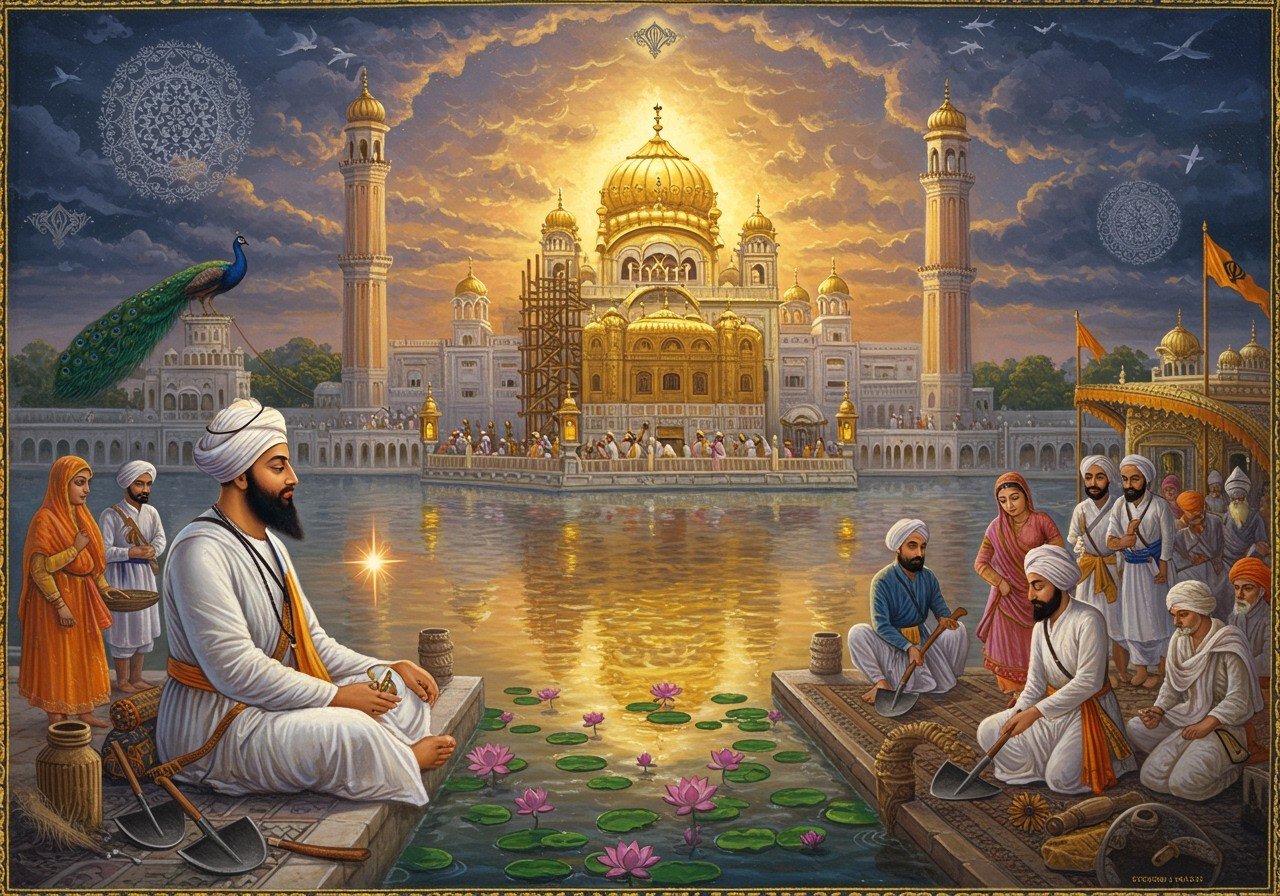
Guru Ram Das Ji, the fourth Sikh Guru, wasn’t just a spiritual leader; he was a builder of communities, a beacon of hope, and a visionary who shaped the spiritual landscape of India. His deep-rooted spirituality and humility resonated with everyone he met. Born in 1534, he became the fourth Sikh Guru in 1574. His teachings, centered on selfless service, equality, and unwavering devotion, still guide Sikhs today. He strengthened the Sikh community, emphasizing the spirit of seva (service) and establishing the Langar, the community kitchen that offers free meals to all, irrespective of their background.
The Birth of Amritsar: A Divine Inspiration
In 1577, Guru Ram Das Ji laid the foundation for what would become the spiritual heart of Sikhism: Amritsar. He envisioned a city that would not only be a place of worship but also a thriving hub of culture and community. The land, whether a gift from Emperor Akbar or purchased from local villagers, became the cradle of a city that continues to flourish. Central to this vision was the Amrit Sarovar, the “Pool of Nectar,” excavated under his guidance. This sacred pool became a source of spiritual sustenance, drawing people from far and wide. The town, initially known as Ramdaspur, blossomed around this divine reservoir, attracting merchants, traders, and families seeking a life rooted in faith and community.
The Golden Temple: A Beacon of Faith
The Harmandir Sahib, lovingly known as the Golden Temple, stands as a testament to Guru Ram Das Ji’s vision and the continued efforts of his successor, Guru Arjan Dev Ji. While Guru Ram Das Ji conceptualized the sacred pool, Guru Arjan Dev Ji brought the Golden Temple to life, erecting it on an island in the Amrit Sarovar, reached by a marble causeway symbolizing the path of devotion. Centuries later, during Maharaja Ranjit Singh’s reign (1801-1839), the temple’s dome was adorned with gold foil, giving it the iconic appearance we know today. The Golden Temple welcomes people from all walks of life, offering a sanctuary for peace and reflection. Just like the Jyotiba Temple, another significant pilgrimage site, it stands as a symbol of devotion and spiritual seeking.
Guru Ram Das Teri Nagri: A Prayer, A Connection
The phrase “Guru Ram Das Teri Nagri,” often recited in Sikh prayers and hymns, acknowledges Amritsar as a city blessed by Guru Ram Das Ji’s legacy. These words resonate deeply with Sikhs worldwide, expressing their reverence and connection to this sacred city. They serve as a reminder of the Guru’s enduring presence and the spiritual significance of Amritsar.
Amritsar: Where Spirituality and Culture Embrace
From its humble beginnings as Ramdaspur, Amritsar has blossomed into a vibrant cultural and spiritual center for the Sikh community. It stands as a beacon of Sikh heritage, drawing pilgrims who seek to connect with their roots and strengthen their faith. The city is alive with vibrant festivals, traditional cuisine, and intricate crafts, each element reflecting its rich history and diversity. Amritsar exemplifies the beautiful coexistence of tradition and modernity, embracing its heritage while welcoming progress. Much like how Parshuram’s legacy is honored through temples and rituals, Amritsar continues to cherish and celebrate its spiritual heritage.
Honoring the Legacy with Poojn.in
At poojn.in, we understand the deep significance of honoring our Gurus and celebrating our spiritual heritage. We offer a thoughtfully curated selection of items that can enhance your devotional practices and help you connect with the spirit of Amritsar.
Essential Items for Your Devotional Practices:
- Pure Offerings: Sourcing the finest ingredients for your spiritual offerings is paramount. We offer premium quality Karah Prasad ingredients, pure desi ghee for preparing Langar, and fresh dry fruits for Prasad distribution. Our Guru Chandan Tilak adds a touch of tradition to your prayers.
- Prayer Items: Elevate your prayer space with our authentic brass diyas, perfect for performing aarti in the Harmandir Sahib style. We also offer cotton wicks for maintaining an Akhand Jyoti (continuous flame) and pure copper vessels for Amrit (holy water). Our stainless steel achmani spoons are ideal for traditional rituals.
- Sacred Texts: Treat your Guru Granth Sahib with reverence using our ornate covers and sturdy stands. We also have prayer books containing Gurbani and protective carrying cases for your holy texts.
Connecting with poojn.in:
- Website: www.poojn.in
- Phone: 03369029784
- WhatsApp: 9476142738
(Note: Product availability is subject to change. Please visit our website or contact us for the latest prices and stock information.)
A Legacy that Continues to Inspire
Guru Ram Das Ji’s legacy in Amritsar is a shining example of how faith and vision can transform a community. The Golden Temple, a beacon of spirituality, stands as a testament to his teachings of love, humility, and service. Today, Amritsar thrives as a blend of tradition and progress, welcoming visitors from all backgrounds to experience the heart of Sikhism. Its lively streets, filled with the aroma of traditional food and the sounds of celebration, invite everyone to partake in its unique charm. As we reflect on the history of Amritsar, we honor Guru Ram Das Ji’s vision and the enduring spirit of the city he founded. Similar to the enduring influence of Tulsi Peeth and Acharya Ramchandra Das, Amritsar continues to inspire and unite people through faith, culture, and community.
Common Questions about Guru Ram Das Ji and Amritsar
Who was Guru Ram Das? Guru Ram Das Ji was the fourth of the ten revered Sikh Gurus, instrumental in shaping the Sikh faith and establishing the city of Amritsar as a spiritual center. His teachings emphasize seva (selfless service), equality, and devotion. He also played a crucial role in establishing the Langar, the community kitchen that serves free meals to everyone regardless of background.
Which city did Guru Ram Das found? Guru Ram Das Ji founded the city of Amritsar, a significant spiritual and cultural hub for Sikhs worldwide. The city is renowned for its vibrant culture, rich history, and the iconic Golden Temple.
Why is Amritsar important in Sikhism? Amritsar holds immense importance as the home of the Harmandir Sahib, also known as the Golden Temple, the holiest shrine in Sikhism. It serves as a central point of pilgrimage and a powerful symbol of Sikh identity and heritage.
How is Guru Ram Das connected to the Amritsar Temple? Guru Ram Das Ji initiated the construction of the Amrit Sarovar (the sacred pool) and laid the groundwork for the Golden Temple, which was later completed by his successor, Guru Arjan Dev Ji. The temple is situated on an island in the Amrit Sarovar and is a testament to the vision and leadership of the Sikh Gurus.
What does “Guru Ram Das Teri Nagri” mean? “Guru Ram Das Teri Nagri” translates to “O Guru Ram Das, this is your city.” This phrase expresses deep devotion and reverence for Guru Ram Das and the city he founded. It is often recited in Sikh prayers and hymns as a way of acknowledging the Guru’s blessings and spiritual presence in Amritsar.
Why is Guru Ram Das important in Sikh history? Guru Ram Das Ji’s contributions to Sikhism are immeasurable. His teachings, leadership, and establishment of Amritsar have had a profound and lasting impact on the Sikh community. His vision shaped the spiritual and cultural landscape of Sikhism, making him a revered figure in Sikh history.
How did Amritsar get its name? Amritsar derives its name from the Amrit Sarovar, meaning “Pool of Nectar.” This sacred pool, excavated under Guru Ram Das Ji’s guidance, is not just a body of water but a symbol of spiritual purification and renewal. The city’s name reflects the spiritual significance of the pool and its importance to the Sikh faith.


